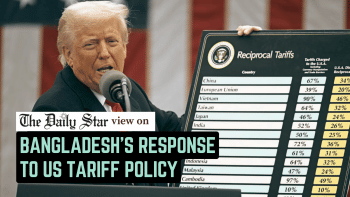What should be our game plan to tackle global volatility?

In the aftermath of Trump's tariffs, the chief adviser's visit to China, and as the BIDA investment takes place, Mustafizur Rahman, distinguished fellow at the Centre for Policy Dialogue (CPD), speaks to Ramisa Rob of The Daily Star about how Bangladesh can navigate the current challenges.
What economic opportunities can come from strengthening Bangladesh's bilateral ties with China?
The Chief Adviser's recent visit to China was of heightened importance to Bangladesh from multiple perspectives. First of all, China is our major bilateral trading partner and the most important source of our imports. Over the last few years, average imports from China were about $20 billion, and these imports from China are crucial for many of our export-oriented industries, domestic import-substitute industries, and also for our consumers. On the other hand, China plays a crucial role in Bangladesh's infrastructure scenarios and has its footprints in many of our major infrastructure projects, including the Padma Bridge, rail connectivity over the Padma River, Karnaphuli tunnel and many other economic, social and digital infrastructure. Bangladesh has been a part of the Belt and Road Initiative (BRI), and many projects are being implemented as part of the initiative.
There exists significant Chinese investment in Bangladesh in various sectors, but not to the extent that we had hoped for. The plan to build a Chinese Economic Zone on the south bank of the River Karnaphuli could not be realised on time but there is a plan in place to revive it. China also remains the predominant source of Bangladesh's defence-related imports.
Bangladesh has taken loans, particularly from Exim Bank of China, for various development projects focused on economic, social, and transport infrastructure, as well as to establish digital connectivity. The Chief Adviser's visit was thus an excellent opportunity not only to deepen bilateral economic relations, but also to open discussions on re-examining the terms of the loans, attracting investment to Bangladesh, and exploring opportunities for further borrowings from China. Most of the loans from China were incurred at 2 percent interest, with a grace period and repayment period of 5-10 years and 20 years, respectively. This was important given that Bangladesh's forex reserves are under pressure and debt servicing liabilities are growing.
It was announced following the meeting that about $2 billion worth of investment will be forthcoming from China. China will explore shifting some of its industries to Bangladesh, which could give Bangladesh competitive edge in exporting to China and other markets. Until now, most of the Chinese investments and sunset industries have been going to Vietnam, Cambodia, and other East Asian countries. Bangladesh could be a major hub for Chinese investment, particularly if the proposed dedicated SEZ could be established at an early date.
As reported, Beijing expressed its willingness to start negotiations for a Free Trade Agreement (FTA). What would that entail?
The proposed FTA with China will need to be carefully considered as there are revenue loss concerns if we provide zero tariffs to imports from China. On the other hand, if we receive preferential market access in China as part of an FTA, from a short run perspective its significance will be limited, as our exports are relatively low. For now, we are getting duty-free, quota-free access to the Chinese market under the Chinese GSP scheme for the Least Developed Countries (LDCs). In this regard, China's offer to extend preferential market access till 2028, two years beyond Bangladesh's upcoming LDC graduation, during the Chief Adviser's visit, is a positive development.
If we are able to triangulate trade, investment, transport connectivities, and other forms of cooperation—such as technology transfer, productivity enhancement, and Chinese investment in Bangladesh—the prepared FTA, in the form of a Comprehensive Economic Partnership Agreement, will be beneficial for Bangladesh. It also has to be based on reciprocity, taking into account the differences in our economic levels.
With India-China rivalry, and tensions between Bangladesh and India, what should the geostrategic framework be?
I presume balancing the relationship between India and China remains at the core of Bangladesh's current geostrategic outlook. Bangladesh's strengthened ties with China should not be seen as contradicting Bangladesh's clearly articulated policy to deepen cooperation with India. Both these will need to be on the basis of win-win outcomes.
India remains a major trading partner of Bangladesh, for many consumer goods with advantages in terms of price competitiveness and lead time. Bangladesh has received $8 billion from India, and many projects are being implemented under this credit. The duty-free, quota-free market access provided by India to Bangladesh for almost all items originating from the country has benefitted Bangladesh's consumers, producers and exporters.
Of course, there are some issues in view of deepening bilateral ties with India that cannot be ignored, such as the sharing of water of Teesta River and the management of all the rivers that we share. But Bangladesh is keen to negotiate on these issues, including joint river basin management.
At one time, we were very hopeful that the proposed Bangladesh-China-India-Myanmar (BCIM) Economic Corridor would play an important role in deepening transport, trade, investment, logistics, and people-to-people connectivity. Regrettably, following a promising start, the BCIM Economic Corridor project has become dormant now. These types of multilateral cooperation initiatives can help Bangladesh take advantage of its geostrategic location while easing regional tensions.
In this context, Trump tariffs are another geo-economic issue hovering over the nation. What steps should the interim government take?
The Trump tariffs reinforce Bangladesh's need to pursue market and product diversification and to deepen regional cooperation. Our strategy should be two-pronged. First, Bangladesh will need to engage with the US, which is Bangladesh's single largest export destination. Bangladesh has already taken a number of initiatives including the Chief Adviser writing to President Trump. The NBR is examining what we can offer the US. At the same time, this serves as a reminder that the global trading scenario is becoming increasingly uncertain. For weaker economies like Bangladesh, a rules-based multilateral trading system remains the best option, but the WTO has been weakened irreparably by US policies.
Second, while we tackle short- and medium-term ramifications of the tariffs, we should also pursue multilateral initiatives such as reviving SAARC and strengthening our bilateral ties with regional countries such as China and India to reduce dependence on the US. At the recently held Sixth Summit of the Bay of Bengal Initiative for Multi-Sectoral Technical and Economic Cooperation (BIMSTEC), the Report of the Eminent Persons Group (EPG) and the Bangkok Vision 2030 have been adopted, and the maritime transport agreement has been signed. As part of a broader strategy to address global trade volatility, we should also consider strengthening ties with ASEAN, which is part of the Regional Comprehensive Economic Partnership (RCEP) Agreement.
Bangladesh has strong arguments to engage with the US. First, though we have a bilateral trade surplus with the US of around $7 billion, we are one of the major importers of US cotton, which is used in our RMG exports to the US. In this way, Bangladesh's imports from the US are closely tied to US exports to Bangladesh. Second, there are no import duties on US import products such as cotton, wheat and soybean and others like LPG remain very low. While some imported items do face higher tariffs, Bangladesh may reconsider lowering those, though this has to be done on a Most Favoured Nation basis.
We must carefully study the items where the US has export interests and assess whether, and to what extent, we can lower tariffs to zero and what the revenue implications might be. Another strategy is to improve our trade and investment environment so that more US investment can come to Bangladesh, as FDI from the US is currently very low. Removing the obstacles to US investment should be part of improving our overall investment climate through reducing costs of doing business, and undertaking needed reforms.
As we speak, the Bangladesh Investment Development Authority (BIDA) investment summit is taking place. It is very encouraging to see a large number of prominent global investors' keen interest in Bangladesh. If we can provide the necessary services under the One Stop Service Act 2018—such as unencumbered land, appropriate infrastructure, skilled workers and mid-level professionals, quality electricity, and uninterrupted gas—then there is every opportunity to translate investor interest into higher FDI flows to Bangladesh.
A large flow of FDI would help in a few ways: addressing the challenges of LDC graduation and emergent volatile global trading scenario; creating decent jobs; greater export product and market diversification; and paving the way for Bangladesh to leverage FDI to enter regional markets with greater competitive strength. India imports more than $700 billion annually; China, more than $2,800 billion. Yet Bangladesh's exports to India remain around $2 billion, and less than $1 billion in case of China. If we can increase investments targeting the regional markets, we can benefit from the duty-free and quota-free access provided under LDC schemes of India and China. Bangladesh may seek an extension of India's DF-QF market access beyond the LDC graduation timeline to maximise the benefits.
The BIDA investment conference should also be viewed as a way to address the challenges posed by the Trump tariffs and LDC graduation. Given its strategic position, with four seaports on the Bay of Bengal, Bangladesh could be a major hub for maritime routes and transportation which will also create investment opportunities that can be harnessed in a win-win manner. To achieve this, macroeconomic stability and a conductive political environment will be crucially important.
Does the current explosive geopolitical landscape make transitioning from LDC status even more challenging?
The Trump tariffs and the broader challenges in the global market once again reinforce the need for Bangladesh to take proactive steps towards smooth and sustainable LDC graduation. Opportunities created by the BIDA investment summit, as well as bilateral discussions held in China, and the meeting between the Chief Adviser and Prime Minister Modi, should all be seen as part of navigating the turbulent waters of geoeconomics and geopolitics which will be necessary if Bangladesh is to move towards LDC graduation with momentum. Post-graduation, we will no longer have duty-free, quota-free market access. The pressure to comply with intellectual property rights, labour standards, and environmental regulations will increase. If we want to attract FDI, we will have to improve compliance in these areas as well. Workers and producers will need to be provided with necessary support to raise competitiveness through higher labour and capital productivity. A "whole of society" and "whole of economy approach" will be key to moving towards sustainable LDC graduation.
Views expressed in this article are the author's own.
Follow The Daily Star Opinion on Facebook for the latest opinions, commentaries and analyses by experts and professionals. To contribute your article or letter to The Daily Star Opinion, see our guidelines for submission.


 For all latest news, follow The Daily Star's Google News channel.
For all latest news, follow The Daily Star's Google News channel. 










Comments